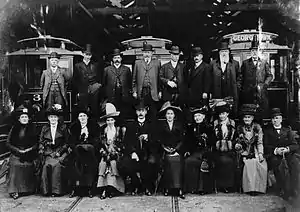Transport in Invercargill
Transport in Invercargill, New Zealand is mostly by bus and private car.
Roads
Invercargill is the southernmost city on New Zealand's state highway network and is linked to Fiordland and the Catlins by the Southern Scenic Route and Dunedin and Gore by SH 1. It is also the southern end of SH 6 coming from Queenstown and the West Coast. The main streets of Invercargill: Dee (SH 6) and Tay (SH 1) measure over 40 metres wide. Numerous roads in the city are dual-carriageway but there are no expressways/motorways proposed for the city.
Railways

Invercargill was the first town in New Zealand to have a steam locomotive and was once the centre of a much larger rail network than at present. It is at the southern end of the Main South Line railway, which extends up the east coast to Christchurch and Lyttelton via Dunedin. Until the cancellation of The Southerner in 2002, Invercargill had the southernmost passenger railway station in the world. Passenger trains no longer call at Invercargill, except for occasional excursions. The Bluff Branch extends south from Invercargill and has been freight-only since 1967. The Wairio Branch extends northwest from Invercargill to the Solid Energy coalfields near Ohai and continues to carry freight even after the closing of the Ohai coal mine.
Airport
During the mid-1950s, Invercargill Airport was used for fuel top-up and final take off by Operation Deep Freeze. Twin-engine propeller-driven aircraft destined for McMurdo Sound in the Antarctic used the airport, assisted in takeoff by JATO rockets. Larger aircraft flew from Christchurch when a permanent Deep Freeze base was established there.
Air New Zealand operates daily flights to Christchurch and to Wellington plus five weekly flights to Auckland. Stewart Island Flights make regular flights to and from Stewart Island / Rakiura. Mainland Air of Dunedin operates a Piper Navajo and is contracted to fly doctors to Southland Hospital several times per week from Dunedin Hospital.
Southern Wings is the only aeroclub based at the airport and runs charter flights as well as a flight school.
Invercargill Airport has the fourth longest runway in New Zealand at 2210 metres, after Auckland, Christchurch and Ohakea.
Buses
Go Bus Transport provides services under contract to the Invercargill City Council. Bus Smart cards were replaced with Bee Cards on 22 June 2020.[1]
Prior to 1 April 2014, services were run by Invercargill Passenger Transport which was ultimately taken over by Go Bus.
Zero-fare services
Invercargill offered several zero-fare bus services in the first decade of the century.
The Freebie was a zero-fare loop service in the inner city, The Purple Circle was a free suburban bus circuit, and all other suburban bus services operated zero-fare between 9:00 am and 2:30 pm daily. The Mayor of Invercargill, Tim Shadbolt told a conference of New Zealand's Disabled Persons Assembly in October 2002 that Invercargill had an innovative approach to public transport, and that he hoped in future that all buses in Invercargill would be free and accessible.[2]
However, central government requirements (NZ Transport Agency) for regional authorities to aim for a 50% fare recovery from public transport led to Invercargill's zero-fare services being discontinued,[3] and new bus routes and timetables operated by BusSmart were introduced in December 2012. Senior citizens are still provided free off-peak travel via the government's SuperGold Travel Scheme.[4] BusSmart's new routes are Waikiwi Link, Windsor Comet, Heidelberg Star and Kew Connection.
Other transport services
Airport transport
Invercargill Airport is only 3 kilometres (1.9 mi) from the centre of the city and transport is mainly by taxi and shuttle van.[5]
Management of public transport
The Invercargill City Council specifies, tenders, subsidises and contracts with bus operators for provision of public transport in Invercargill. Passenger Transport Ltd currently holds this contract.[6]
Past service modes

.jpg.webp)
Trains
From the opening of the Bluff Branch in 1867 until the cancellation of the final service in 1967, passenger trains operated between Invercargill and Bluff for commuters and school children. In 1950, seven trains ran each way on the average weekday, with eight on Fridays, five on Saturdays, and one on Sundays. By 1967, only one train ran each way on weekdays for the benefit of school children, and due to being unviable, it was cancelled.
Trams
Invercargill formerly had the southernmost tram system in the world.[7] Construction began in January 1911 and two lines of 4 ft 8+1⁄2 in (1,435 mm) standard gauge track were opened on 26 March 1912, one to Waikiwi and one to Georgetown. Later that year, two more lines opened, one to North Invercargill and one to South Invercargill; the latter was the southernmost electrified street tram line in the world and ran to Tramway Road.[8] In practice, the network operated as two routes: Route A between Georgetown and Waikiwi and Route B between North and South Invercargill.[9]
The Waikiwi line closed in 1947, though a portion remained in operation until 1951. The Georgetown route was closed on 2 July 1951, but the portion to Rugby Park Stadium remained open until August 1951. The South Invercargill line was next to close, on 31 May 1952, and the system's final route, to North Invercargill, ceased operations on 10 September 1952.[8]
References
- "Bee Card". Invercargill City Council. Retrieved 27 May 2023.
- "Bites October 2002 from DPA NZ - The National Assembly of People with Disabilities". Archived from the original on 2012-03-10.
- "Invercargill's bus 'freebies' may be axed". Archived from the original on 2017-03-18. Retrieved 2020-03-21.
- "Buses". Archived from the original on 2014-10-07. Retrieved 2020-03-21.
- Terminal Facilities on Invercargill Airport website Archived 2002-12-03 at the Wayback Machine
- "Buses". www.icc.govt.nz.
- Graham Stewart, The End of the Penny Section: When Trams Ruled the Streets of New Zealand, rev. ed. (Wellington: Grantham House, 1993), p. 112.
- Stewart, The End of the Penny Section, p. 236.
- Stewart, The End of the Penny Section, p. 142.